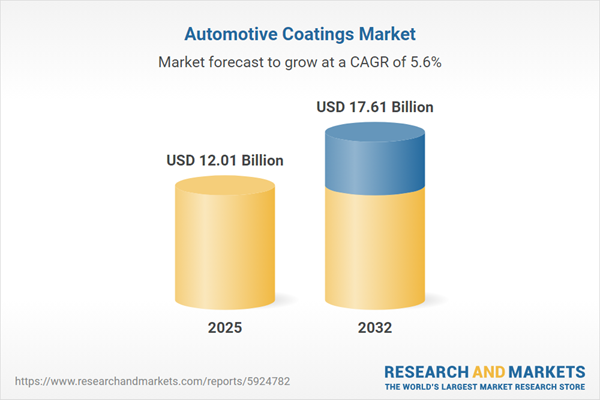Speak directly to the analyst to clarify any post sales queries you may have.
The automotive coatings market is experiencing significant transformation as stakeholders adapt to stricter regulations, advanced technologies, and changing buyer needs. Leaders who prioritize flexibility and forward-thinking strategies are best positioned to succeed amid ongoing shifts.
Market Snapshot: Automotive Coatings Market Size and Growth Outlook
The global automotive coatings market achieved a valuation of USD 11.36 billion in 2024, with projections reaching USD 12.01 billion by 2025. Forecasts point to a compound annual growth rate (CAGR) of 5.63%, leading to an estimated market size of USD 17.61 billion by 2032. This forward momentum is driven by rising demand for environmentally responsible solutions, strict regulatory frameworks, and evolving expectations across original equipment manufacturers and aftermarket channels. Innovations in sustainable raw materials and process efficiency, alongside new vehicle technology requirements, are contributing to a strong market outlook.
Scope & Segmentation in the Automotive Coatings Market
This analysis equips senior executives with insights to navigate the major factors shaping the automotive coatings market and to develop strategic initiatives spanning the entire value chain. Segmentation highlights include:
- Vehicle Types: Addresses heavy-duty and light commercial vehicles, passenger cars, as well as both electric and internal combustion engine platforms. Each type operates under unique regulatory and performance pressures across global markets.
- Applications: Focuses on original manufacturing processes and aftermarket refinishing. Improved production efficiency, robust lifecycle support, and adaptability during repairs are central themes for both OEM and service providers.
- Technologies: Encompasses powder, solvent-borne, waterborne, and UV-curable solutions. Each technology aims to boost sustainability, enhance production flexibility, and strengthen supply chain dependability.
- Product Types: Includes primers, basecoats, clearcoats, surfacers, and topcoats. These products underpin enhanced surface protection, durability, and appearance across varying OEM and aftermarket needs.
- Resin Types: Highlights benefits of acrylics, alkyds, epoxies, and polyurethanes. Key advantages include cost control, excellent adhesion, longevity, and support for streamlined manufacturing processes.
- Geographical Regions: Covers North America, South America, Europe, Middle East and Africa, and Asia-Pacific. Attention is paid to regulatory and consumer landscapes in the United States, China, Germany, and India, reflecting critical differences in product strategies and compliance requirements.
- Leading Companies: Examines profiles and research priorities of PPG Industries, Akzo Nobel N.V., Axalta Coating Systems, BASF SE, Nippon Paint Holdings, Kansai Paint, Sherwin-Williams, RPM International, Jotun, and Hempel. These players drive industry standards through innovation and investment.
Key Takeaways for Senior Decision-Makers
- New coating technologies are enabling lighter vehicle structures and fostering adoption of electric vehicle models, helping manufacturers align with shifting customer preferences.
- Increased investment in waterborne and UV-curable coatings reflects an emphasis on regulatory compliance and improved operational practices, strengthening manufacturers’ positions in a highly regulated context.
- Companies are diversifying materials and upgrading offerings such as basecoats and clearcoats, addressing heightened standards for vehicle protection, durability, and aesthetics.
- The aftermarket is focusing on quality assurance and logistics, responding to growing demands for elevated performance and conformance to stricter regulations.
- Localized supply and distribution are enhancing business agility, enabling companies to respond more efficiently to region-specific codes and shifting consumer trends.
Tariff Impact: Navigating the Changing U.S. Trade Landscape
Recent tariff changes affecting U.S. imports of automotive coatings inputs have prompted industry participants to reinforce supply chains and pursue more cost-effective sourcing strategies. To manage increased operational expenditures and supply continuity, many companies are revising coating formulations and entering new vendor negotiations, adjusting quickly to evolving regulatory directives in a changing trade environment.
Methodology & Data Sources
This report draws from a multifaceted research approach, incorporating insights from coatings industry specialists, OEM executives, and leading service organizations. Relevant industry publications and regulatory documents have been reviewed, ensuring the analysis provides a strong foundation for strategic decisions in the automotive coatings segment.
Why This Report Matters
- Supports executive teams in anticipating regulatory and technological changes, allowing for the development of agile, market-aligned strategies across both OEM and aftermarket business lines.
- Facilitates the tailoring of compliance solutions by analyzing diverse regional requirements, helping organizations achieve greater adaptability and optimized resource planning.
- Delivers actionable recommendations for streamlining processes, optimizing capital investment, and deploying resources effectively throughout the automotive coatings supply chain.
Conclusion
By staying attuned to market, regulatory, and technological trends, senior leaders can unlock new avenues for growth and resilience in the automotive coatings sector.
Additional Product Information:
- Purchase of this report includes 1 year online access with quarterly updates.
- This report can be updated on request. Please contact our Customer Experience team using the Ask a Question widget on our website.
Table of Contents
3. Executive Summary
4. Market Overview
7. Cumulative Impact of Artificial Intelligence 2025
Companies Mentioned
The companies profiled in this Automotive Coatings market report include:- PPG Industries, Inc.
- Akzo Nobel N.V.
- Axalta Coating Systems Ltd.
- BASF SE
- Nippon Paint Holdings Co., Ltd.
- Kansai Paint Co., Ltd.
- The Sherwin-Williams Company
- RPM International Inc.
- Jotun A/S
- Hempel A/S
Table Information
| Report Attribute | Details |
|---|---|
| No. of Pages | 188 |
| Published | October 2025 |
| Forecast Period | 2025 - 2032 |
| Estimated Market Value ( USD | $ 12.01 Billion |
| Forecasted Market Value ( USD | $ 17.61 Billion |
| Compound Annual Growth Rate | 5.6% |
| Regions Covered | Global |
| No. of Companies Mentioned | 11 |









